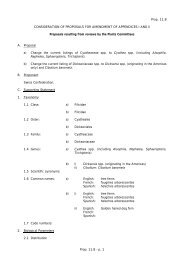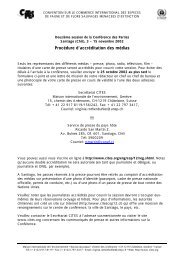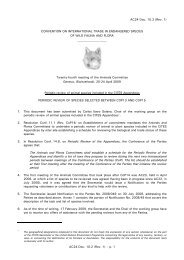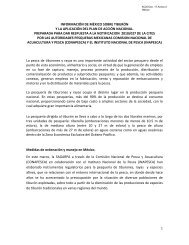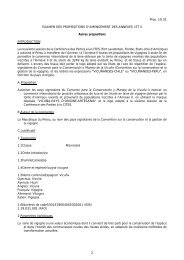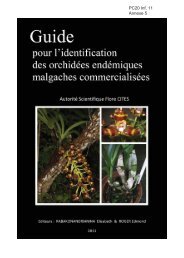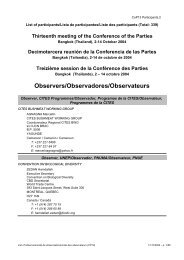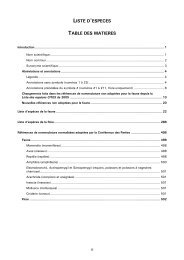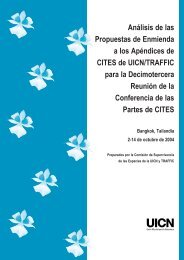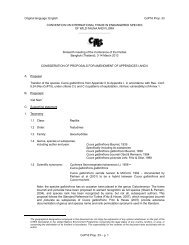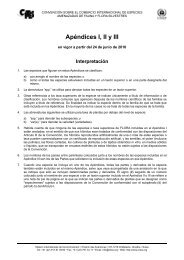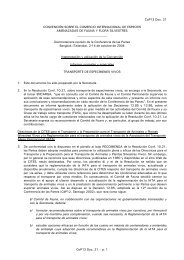Lamna nasus - Cites
Lamna nasus - Cites
Lamna nasus - Cites
You also want an ePaper? Increase the reach of your titles
YUMPU automatically turns print PDFs into web optimized ePapers that Google loves.
Draft Proposal to list <strong>Lamna</strong> <strong>nasus</strong> in Appendix II - prepared by Germany in January 2012<br />
(Source TRAFFIC East and Southern Africa, 2011). None of these fishing entities report porbeagle catches to<br />
FAO.<br />
Two non-range States (and previously unknown players in the market for this species) also reported exports to<br />
the EU: Senegal and Suriname. However, determining the origin of the meat in trade is fraught with<br />
difficulties (as noted above for South Africa), due to countries fishing in international waters and the<br />
inconsistencies in reporting between different countries (flag State versus port State exports, exports reported<br />
after landing or only after processing etc.).<br />
Average prices of imports ranged from only 1.26 EUR/kg for meat imported from Japan to 3.64 EUR/kg for<br />
meat imported from the Faroe Islands. This is significantly lower than prices reported in earlier years for<br />
porbeagle landed into European ports.<br />
Earlier studies had reported that Canada exports L. <strong>nasus</strong> meat to the US and the EU, Japan exports to the EU,<br />
and EU Member States export L. <strong>nasus</strong> to the US, where it is mainly consumed in restaurants (Vannuccini<br />
1999, S. Campana in litt. to IUCN Shark Specialist Group 2006). L. <strong>nasus</strong> is also imported by Japan (Sonu<br />
1998). The new EU trade data confirm exports from Japan to the EU. In Australia, data on exports of L. <strong>nasus</strong><br />
to the US are grouped with Mako Sharks (Ian Cresswell, CITES Management Authority of Australia, in litt. to<br />
BMU, February 2004). Until targeted Customs control and monitoring systems or compulsory reporting<br />
mechanisms to FAO are established, data on non-European international trade in L. <strong>nasus</strong> products will not be<br />
available.<br />
The EU also reported significant exports of porbeagle, particularly in 2010 (68,200kg). These may have been<br />
exports of catches landed and frozen in 2009, before the zero quota, or re-exports. Morocco was by far the<br />
largest destination of porbeagle exported from the EU in 2010, followed by Afghanistan in 2011. However,<br />
the price of porbeagle exported to Morocco was very low (average 0.69 EUR/kg) compared to 17.81 EUR/kg<br />
for porbeagle exported to China and 3-4 EUR/kg for porbeagle exported to Ceuta (Spanish territory in North<br />
Africa), Andorra, Afghanistan and Switzerland. All exports from the EU were from Spain, except those to<br />
Switzerland which came from Denmark. There were no records of the EU importing porbeagle from Canada,<br />
or of the EU exporting (or re-exporting) to the US, as reported in earlier studies.<br />
EUROSTAT also records intra-EU trade – dispatches (equivalent to exports within the EU) and arrivals<br />
(equivalent to imports). However, due to movement of commodities between EU Member States, the<br />
likelihood of double-counting is high. Also there are often considerable discrepancies between quantities<br />
reported as “arrivals” and “dispatches” within the EU (for example if one Member State only reports value,<br />
and the other just weight). Total amounts of specific commodities in trade are therefore difficult to estimate,<br />
however intra-EU trade data can provide an indication of the most important Member States involved in the<br />
trade. In 2010 and 2011 Italy (72%) and Spain (21%) were the principal destinations for trade of porbeagle<br />
commodities (fresh and frozen) within the EU, and Portugal (45%) and Spain (39%) were the principal<br />
suppliers of products traded within the EU. <strong>Lamna</strong> <strong>nasus</strong> (Vitello di Mare) was on sale in Venice Fish market,<br />
Italy, in November 2010 for 12.80 EUR/kg (pers. comm. Mats Forslund, WWF-SE).<br />
The US Fish & Wildlife Service (USFWS) holds only 20 records of US trade in <strong>Lamna</strong> species between 1998<br />
and 2010 (seven of these being specifically of <strong>Lamna</strong> <strong>nasus</strong>). Trade involved 13 live specimens for zoos, three<br />
bodies for museums and ~20,000 units of jewellery, teeth, bone or skins (source: TRAFFIC North America).<br />
6.3 Parts and derivatives in trade<br />
Meat: This can be a very high value product, one of the most palatable and valuable of shark species, and is<br />
traded in fresh and frozen form (see sections 6.1 and 6.2).<br />
Fins: Porbeagle appears in the list of preferred species for fins in Indonesia (along with Guitarfish, Tiger,<br />
Mako, Sawfish, Sandbar, Bull, Hammerhead, Blacktip, Thresher and Blue Shark, see Vannuccini 1999), but<br />
was reported to be relatively low value by McCoy and Ishihara (1999, quoting Fong and Anderson 1998). The<br />
large size of L. <strong>nasus</strong> fins nonetheless means that these are a relatively high value product. They have been<br />
identified in the fin trade in Hong Kong and are one of six species (including Makos, Blue, Dusky and Silky<br />
Sharks) frequently used in the global fin market (Shivji et al. 2002). The raw fins are also readily recognised<br />
to species level by fin traders in Chile (Hernandez et al. 2008). New Zealand has established conversion<br />
factors for L. <strong>nasus</strong> for wet fin (45) and dried fin (108) (equivalent to a weight ratio of 2.2% and 0.9%<br />
respectively) in order to monitor quota and establish the size of former catches by scaling up reported landings<br />
(Ministry of Fisheries, 2005). The wet fin weight ratio from the Canadian fishery is 1.8–2.8% (S. Campana<br />
pers. comm., DFO).<br />
Page 10 of 14<br />
AC26 Doc. 26.2, Annex 1 – p. 10<br />
AC26 Doc. 26.2<br />
Annex / Anexo /Annexe<br />
(English only / únicamente en inglés / seulement en anglais)




